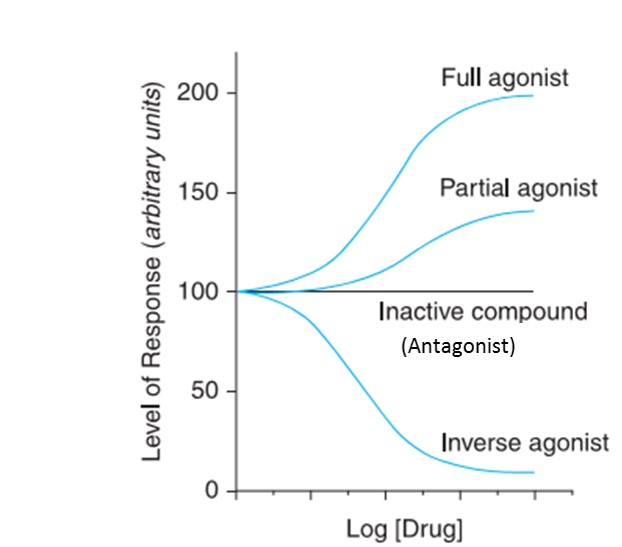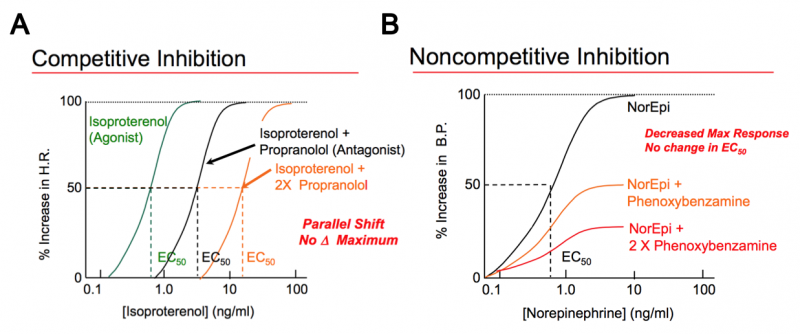3. Combination effects of drugs
Agonist: Many drugs act on receptors and often are particularly selective because physiological receptors are specialized to recognize and respond to individual signalling molecules with great selectivity. Drugs that bind to physiological receptors and mimic the regulatory effects of the endogenous signalling compounds are termed as agonists. In other terms, an agonist has a maximal affinity towards receptors and elicit the maximal intrinsic activity.
Direct agonists: These are the drugs which directly binds to a receptor and activates the receptor to produce a biological effect. Example: Acetylcholine binds to nicotinic cholinergic receptors in skeletal muscle to cause skeletal muscle contraction. Acetylcholine is a direct agonist.
Indirect agonists: These drugs don't directly bind to a receptor however, they indirectly increase the biological response of a ligand by inhibiting the catabolism/ increase the release of the ligand etc. Example: Acetylcholinesterase is the enzyme that hydrolyses/degrade the acetylcholine in the neuromuscular junction. Anti-acetylcholinesterase like neostigmine inhibits the degradation of acetylcholine in neuromuscular junction thus increase the biological effect of acetylcholine in the neuromuscular junction. Neostigmine is an indirect agonist.
Partial agonist: Agents that are only partly as effective as agonists no matter the dose employed is termed as partial agonists. The drugs have affinity but show submaximal intrinsic activity and the response is illustrated in Figure-1. Example: Pindolol is a non-selective beta- blocker with partial beta-adrenergic receptors agonist.
Inverse agonists: These drugs stabilize the receptor in its inactive conformation are termed inverse agonists. They produce a response that is opposite of that typically produced by a receptor when it is stimulated by a conventional agonist. The drugs have affinity but show negative intrinsic activity and the response is illustrated in Figure-1. Example: Agonists for the GABAA receptor (such as benzodiazepines) create a sedative effect, whereas inverse agonists have anxiogenic effects (for example, Ro15-4513) or even convulsive effects (certain beta-carbolines).

Figure-4: Combination effects of drugs
Antagonists: these drugs (antagonists) bind to receptors without regulatory effect, and block the binding of the endogenous agonist. Example: Atropine binds to muscarinic cholinergic receptors in intestinal smooth muscles and inhibits the contraction of the muscle. Receptor antagonism can be the competitive and non-competitive type.
Competitive antagonism: Antagonists bind reversibly to the same receptor site as the agonist. Because they bind reversibly and compete for the same binding site, their inhibitory effects can be “surmounted” by addition of a higher concentration of agonist (Figure 2A). This effect produces a rightward parallel shift of the dose-response for the agonist (towards higher concentrations). In the presence of a competitive antagonist, agonists can still produce the same (e.g. 100%) maximal effect as in the absence of an antagonist, the only difference being that higher agonist concentrations are needed to produce the same level of effect. The vast majority of clinically used drugs that act as receptor antagonists are competitive antagonists. Example: the agonist (Isoproterenol) and the antagonist (Propranolol) bind reversibly to the same receptor subtype (β-adrenoceptor).
Non Competitive antagonism: Antagonists either bind irreversibly (e.g. by covalent bonds) to the same site as the agonist or bind to a different site which reduces the binding of the agonist by an allosteric mechanism. The primary effect of a noncompetitive antagonist is a reduction in the maximal effect produced by the agonist (Figure 2B). (In some cases the slope may also be reduced.) In contrast to a competitive antagonist, the effect of a noncompetitive antagonist cannot be reversed by simply increasing the concentration of the agonist, since the law of mass action does not apply. Example: Phenoxybenzamine binds irreversibly (with covalent bonds) to α-adrenergic receptors.

Figure-5: Dose-response curve of competitive and noncompetitive antagonist
Font Face
Background Colour
Font Size
Text Colour

